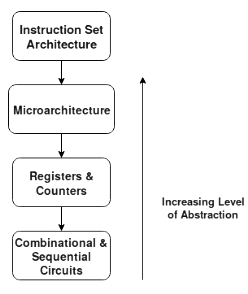Microarchitecture & Instruction Set Architecture | Computer Architecture & Organisation (CAO) - Computer Science Engineering (CSE) PDF Download
Introduction
This basically means that an ISA describes the design of a Computer in terms of the basic operations it must support. The ISA is not concerned with the implementation-specific details of a computer. It is only concerned with the set or collection of basic operations the computer must support. For example, the AMD Athlon and the Core 2 Duo processors have entirely different implementations but they support more or less the same set of basic operations as defined in the x86 Instruction Set.
Let us try to understand the Objectives of an ISA by taking the example of the MIPS ISA. MIPS is one of the most widely used ISAs in education due to its simplicity.
- The ISA defines the types of instructions to be supported by the processor.
- Based on the type of operations they perform MIPS Instructions are classified into 3 types:
- Arithmetic/Logic Instructions:
These Instructions perform various Arithmetic & Logical operations on one or more operands. - Data Transfer Instructions:
These instructions are responsible for the transfer of instructions from memory to the processor registers and vice versa. - Branch and Jump Instructions:
These instructions are responsible for breaking the sequential flow of instructions and jumping to instructions at various other locations, this is necessary for the implementation of functions and conditional statements.
- Arithmetic/Logic Instructions:
- The ISA defines the maximum length of each type of instruction. Since the MIPS is a 32 bit ISA, each instruction must be accommodated within 32 bits.
- The ISA defines the Instruction Format of each type of instruction.
The Instruction Format determines how the entire instruction is encoded within 32 bits
There are 3 types of Instruction Formats in the MIPS ISA:- R-Instruction Format
- I-Instruction Format
- J-Instruction Format
The Abstraction Hierarchy:
- We note that the Microarchitectural level lies just below the ISA level and hence is concerned with the implementation of the basic operations to be supported by the Computer as defined by the ISA. Therefore we can say that the AMD Athlon and Core 2 Duo processors are based on the same ISA but have different microarchitectures with different performance and efficiencies.
Now one may ask the need to distinguish between Microarchitecture and ISA?
- The answer to this lies in the need to standardize and maintain the compatibility of programs across different hardware implementations based on the same ISA. Making different machines compatible with the same set of basic instructions (The ISA) allows the same program to run smoothly on many different machines thereby making it easier for the programmers to document and maintain code for many different machines simultaneously and efficiently.
- This Flexibility is the reason we first define an ISA and then design different microarchitectures complying with this ISA for implementing the machine. The design of a lower-level ISA is one of the major tasks in the study of Computer Architecture.

The x86 was developed by Intel, but we see that almost every year Intel comes up with a new generation of i-series processors. The x86 architecture on which most of the Intel Processors are based essentially remains the same across all these generations but, where they differ is in the underlying Microarchitecture. They differ in their implementation and hence are claimed to have improved Performance. These various Microarchitectures developed by Intel are codenamed as ‘Nehalem’, ‘Sandybridge’, ‘Ivybridge’, and so on.
Therefore, in conclusion, we can say that different machines may be based on the same ISA but have different Microarchitectures.
|
20 videos|87 docs|48 tests
|
|
20 videos|87 docs|48 tests
|

|
Explore Courses for Computer Science Engineering (CSE) exam
|

|

























